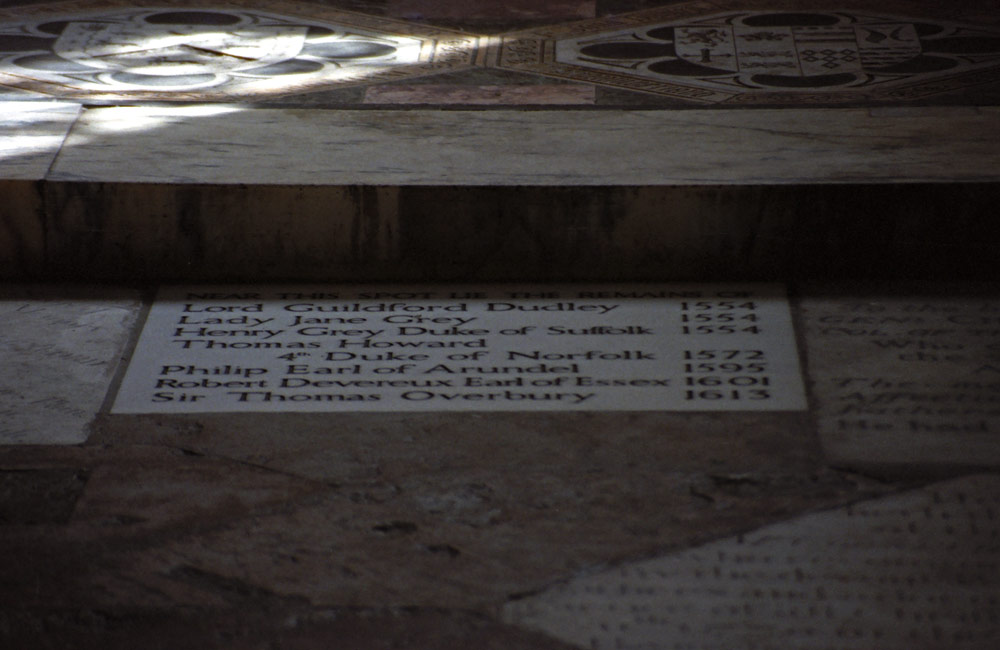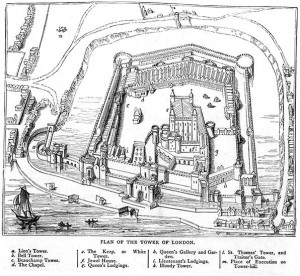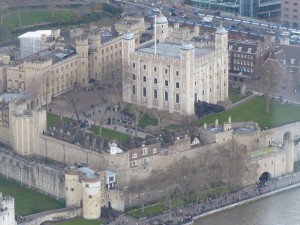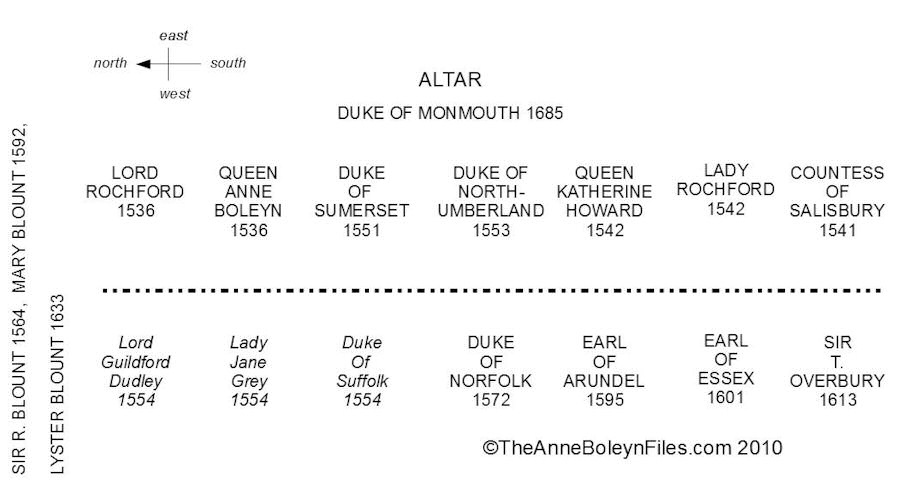Execution of Lady Jane and Lord Guildford Dudley
‘The fortress would become in rapid succession her palace, her prison, her scaffold – and her tomb.’ (p.229, Jones)
On 12th February 1554, Lady Jane Dudley was executed on Tower Green, her husband; Lord Guildford had been executed earlier that morning on Tower Hill.
The author of ‘The Chronicle of Queen Jane and of Two Years of Queen Mary, and Especially of the Rebellion of Sir Thomas Wyat’ described their executions.
‘The Monday, being the xijth of Februarie, about ten of the clocke, ther went out of the Tower to the scaffold on Tower Hill, the lorde Guilforde Dudley, sone to the late duke of Northumberland, husbande to the lady Jane Grey, daughter of the Duke of Suffolke, who at his going tooke by the hand sir Anthony Browne, maister John Throgmortom, and many other gentyllmen, praying them to praie for him; and without the bullwarke Offeley the sheryve received him and brought him to the scaffold, where, after a small declaration, having no gostlye father with him, he kneeled downe and said his praiers; then holding upp his eyes and hands to God many tymes; and at last, after he had desired the people to pray for him, he laide himself along, and his hedd upon the block, which was at one stroke of the axe taken from him.
Note, the lorde marques stode upon the Devy’s towre, and sawe the execution. His carcas throwne into a carre, and his hed in a cloth, he was brought into the chappell within the Tower, wher the ladye Jane, whose lodging was in Partrige’s house, dyd see his ded carcase taken out of the cart, as well as she dyd see him before on lyve going to his deathe, – a sight to hir no lesse then death.
By this tyme was ther a scaffold made upon the grene over against the White tower, for the saide lady Jane to die apon. Who with hir husband was appointed to have ben put to deathe the fryday before, but was staied tyll then, for what cause is not knowen, unless yt were because hir father was not then come into the Tower. The saide lady, being nothing at all abashed, neither with feare of her owne deathe, which then approached, neither with the sight of the ded carcase of hir husbande, when he was brought in to the chappell, came fourthe, the levetenaunt leding hir, in the same gown wherin she was arrayned, hir countenance nothing abashed, neither her eyes anything moysted with teares, although her ij. gentylwomen, mistress Elizabeth Tylney and misrress Eleyn, wonderfully wept, with a boke in hir hande, wheron she praied all the way till she cam to the saide scaffold, wheron when she was mounted &….’
The Ende of the lady Jane Dudley, daughter of the duke of Suffolk, upon the scaffold, at the houre of her death.
‘First, when she mounted upon the scaffold, she sayd to the people standing thereabout: “Good people, I am come hether to die, and by a lawe I am condemned to the same. The facte, in dede, against the quenes highnesse was unlawfull, and the consenting thereunto by me: but touching the procurement and desire therof by me or on my halfe, I doo wash my hands thereof in innocencie, before God, and the face of you, good Christian people, this day,” and therewith she wronge her handes, in which she had hir booke. Then she sayd, “I pray you all, good Christian people, to beare me witnesse that I dye a true Christian woman, and that I looked to be saved by none other meane, but only by the mercy of God in the merites of the blood of his only sonne Jesus Christ: and and I confesse, when I dyd know the word of God I neglected the same, loved my selfe and the world, and therefore this plague or punishment is happily and worthily happened unto me for my sins; and yet I thank God of his goodnesse that he hath geven me a tyme and respet to repent. And now, good people, while I am alive, I pray you to assyst me with your prayers.” And then, knelyng downe, she turned to Feckenam, saying, “Shall I say this psalme?” And he said, “yea.” Then she said the psalme of Miserere mei Deus in English, in most devout maner, to the end. Then she stode up, and gave her maiden mistris Tilney her gloves and handkercher, and her book to maister Bruges, the lyvetenantes brother; forthwith she untied her gown. The hangman went to her to help her of therewith; she desired him to let her alone, turning towardes her two gentlewomen, who helped her off therwith, and also with her frose past and neckercher, giving her a fayre handkercher to knytte about her eyes.
Then the hangman kneeled downe, and asked her forgevenesse, whome she forgave most willingly. Then he willed her to stand upon the strawe: which doing, she sawe the block. Then she sayd, “I pray you dispatch me quickly.” Then she kneeled down, saying, “Will you take it off before I lay me downe?” and the hangman answered her, “No, madame.” She tyed the kercher about her eys; then feeling for the blocke, saide, “What shall I do? Where is it?” One of the standers-by guyding her thereunto, she layde her heade down upon the block, and stretched forth her body and said: “Lorde, into thy hands I commende my spirite!” And so she ended.’ (p.54-59, Nichols)
The Chronicle of the Grey Friars reported that:
‘Item the xij. of Februarij was beheddyd wythin the tower lady Jane that wolde a bene qwene; and hare husband whose name was Gylford Dudley at the Tower-hyll.’
The author of ‘A London Chronicle’ wrote:
‘Vpon Monday, beynge ye xij. day of Februarie, ye lorde Gylforde Dudley, forthe sonne to ye duke of Northumbarland, hosband to ye lady Jane, pretendyd quene, was behedyd at ye Towre hyll: and ye sayd day lady Jane, ye pretendyd queene, was behedyd ye same day wt in ye Towre. Abought two days afore ye duke of Suffolke wt one of his brythern, whiche before fledd to Lester, ther to rays ye people ther to ayd syr Thomas Wyat, was brought in to ye Towre of London.’
On 12 February Simon Renard wrote to the Emperor that:
‘Now that God had shown her the grace of placing the exercise of justice in her hands, I thought she ought not to lose the opportunity of punishing the shameful infidelity of those who had conspired against her person and crown, but also see to the chastisement of Courtenay and Elizabeth, the two persons most able to cause trouble in the realm, since they had notoriously sinned and deserved death, after which she need have no fear for her crown, as Jane of Suffolk and Guildford, her husband, were to be beheaded, and the whole house of Suffolk would be obliterated by the execution of the three brothers now prisoners, whose death, as they were heretics, would contribute to the firm re-establishment of religion.’
On the 13th February Renard reported Jane’s execution to the Emperor:
‘Yesterday Courtenay, chief of the conspiracy according to Wyatt, was committed to the Tower, and the Lady Elizabeth set out to come hither. She is expected to-morrow with an escort of 700 or 800 horse, and it is believed that she will soon be sent to the Tower, where Jane of Suffolk was yesterday executed, whilst her husband, Guildford, suffered in public.’
The Spanish ambassador’s letter to Prince Philip on February 19th, described the rebellion against Queen Mary:
‘At present there is no other occupation than the cutting off of heads and inflicting exemplary punishments Jane of Suffolk, who made herself Queen, and her husband, have been executed…’
Peter Martyr wrote to Henry Bullinger on 3 April 1554 that:
‘Jane, who was formerly queen, conducted herself at her execution with the greatest fortitude and godliness, as did also her father and her husband.’ (Letter CCXLI, Robsinson)
Thomas Lever wrote to Henry Bullinger on 11 April 1554 that:
‘He said that only the duke of Suffolk, and his daughter lady Jane, with her husband, were beheaded, and that they all continued stedfast in the profession of the true religion.’ (Letter LXXVII, Robinson)
Location
The Tower of London is in central London on the north bank of the Thames.

From ‘A view of London, Westminster and Southwark, as they appeared A.D. 1543. 19th Century engraving by Nathaniel Whittock from a drawing by Antony van den Wyngaerde’
Wikimedia Commons

Close up of the Tower of London and the scaffold on Tower Hill where Guildford Dudley died.
From ‘A view of London, Westminster and Southwark, as they appeared A.D. 1543. 19th Century engraving by Nathaniel Whittock from a drawing by Antony van den Wyngaerde’
Wikimedia Commons
St Peter ad Vincula where Jane and Guilford are buried is marked as d. The Chapel.
Some Key Dates in the Tudor History of the Tower of London
‘1503 – 11 February – Queen Elizabeth of York dies just over a week after giving birth.
1509 – 21 June – King Henry VIII arrives at the Tower to prepare for his coronation.
1536 – 19 May – Anne Boleyn is executed.
1542 – 13 February – Katherine Howard and Lady Jane Rochford are executed.
1547 – 19 February – King Edward VI leaves for his coronation procession.
1553 – 10 July – Queen Jane takes possession of the Tower.
1553 – 19 July – Queen Jane’s reign ends at the Tower.
1553 – 3 August – Queen Mary I takes possession of the Tower.
1553 – 22 August – John Dudley, Duke of Northumberland is executed.
1553 – 29 August – The author of the ‘Chronicle of Queen Jane etc’ dines with Lady Jane at Nathaniel Partridge’s house.
1554 – 12 February – Lady Jane and Lord Guildford Dudley are executed.
1554 – 23 February – Henry Grey, Duke of Suffolk is executed.
1558 – 12 January – Elizabeth I arrives to prepare for her coronation.’
From ‘On This Day in Tudor History by Claire Ridgway.’
The Tower of London Today
‘Gentle visitor pause awhile : where you stand death cut away the light of many days : here jewelled names were broken from the vivid thread of life : may they rest in peace while we walk the generations around their strife and courage : under there restless skies’.
Brian Catling, creator of the execution site memorial.
http://www.hrp.org.uk/TowerOfLondon/stories/towergreen

Plaque commemorating Jane, Guildford, Henry, Duke of Suffolk and others in St Peter ad Vincula.
(c) Lara Eakins
Thank you to Claire at The Anne Boleyn Files and Lara at Tudor History for the use of their pictures and photos.
Sources
Jones, N. (2011) Tower: An Epic History of the Tower of London, Windmill Books
Nichols, J. G (ed) (1850) The Chronicle of Queen Jane and of Two Years of Queen Mary and Especially of the Rebellion of Sir Thomas Wyatt, Written by a Resident in the Tower of London, Llanerch Publishers
Ridgway, C. (2012) On This Day in Tudor History, Made Global Publishing.
Robinson, H. (ed) (1846) Original Letters Relative to the English Reformation, Written during the Reigns of King Henry VIII, King Edward VI and Queen Mary (Volume One), University Press
The Chronicle of the Grey Friars: Mary’, Chronicle of the Grey Friars of London: Camden Society old series, volume 53 (1852), pp. 80-98. URL: http://www.britishhistory.ac.uk/report.aspx?compid=51590 Date accessed: 14 January 2014
A London Chronicle: Mary’, Two London Chronicles from the Collections of John Stow (1910), pp. 27-43. URL: http://www.british-history.ac.uk/report.aspx?compid=81145 Date accessed: 14 January 2014
‘Spain: February 1554, 11-15’, Calendar of State Papers, Spain, Volume 12: 1554 (1949), pp. 93-100. URL: http://www.british-history.ac.uk/report.aspx?compid=88540 Date accessed: 14 January 2014
‘Spain: February 1554, 11-15’, Calendar of State Papers, Spain, Volume 12: 1554 (1949), pp. 93-100. URL: http://www.british-history.ac.uk/report.aspx?compid=88540 Date accessed: 14 January 2014
‘Spain: February 1554, 16-20’, Calendar of State Papers, Spain, Volume 12: 1554 (1949), pp. 100-123. URL: http://www.british-history.ac.uk/report.aspx?compid=88541 Date accessed: 14 January 2014
‘Spain: February 1554, 16-20’, Calendar of State Papers, Spain, Volume 12: 1554 (1949), pp. 100-123. URL: http://www.british-history.ac.uk/report.aspx?compid=88541 Date accessed: 14 January 2014
The Anne Boleyn Files – Burial positions in St Peter ad Vincula
The Anne Boleyn Files – Plan of Tower of London
Tudor History – Plaque commemorating Lady Jane, Lord Guildford and others in St Peter ad Vincula









































